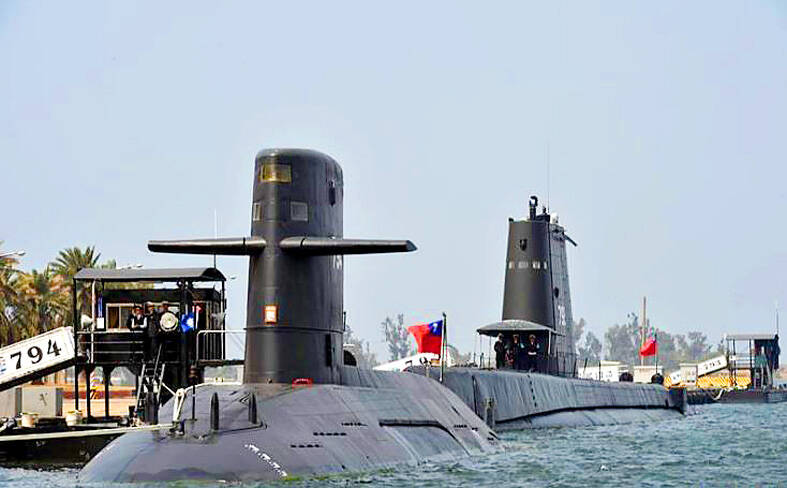The Indigenous Defense Submarine (IDS) prototype is expected to undergo a harbor acceptance test in September, a sea acceptance test in February next year and, if it passes, be delivered to the navy in the first half of 2025 instead of November 2025, defense officials said yesterday.
The goal of the IDS program is to create a fleet of nine to 11 domestic diesel-electric submarines that would defend the waters around Taiwan, the officials said, speaking on condition of anonymity.
The IDS prototype features a partial double-hull design consisting of six pressurized compartments and a conning tower, which have been completed, certified and are undergoing encapsulation, they said.

Photo: Taipei Times, file photo
The boat would be 70m long, 8m wide and 18m high, including the conning tower, and have a displacement of 2,500 tonnes to 3,000 tonnes, the officials said.
It would have a pair of stabilizing fins on the sides of the conning tower and an X-shaped tail rudder, they added.
The submarine’s weapons would include 18 MK 48 Mod 6 heavyweight torpedoes and an undisclosed number of Harpoon missiles, they said.
There is reason to believe that due to improved program management the prototype could be completed ahead of schedule in early 2025 or before that, if system tests are successful, the officials said, adding that the project had generous time buffers.
Meanwhile, the Chungshan Institute of Science and Technology is poised to deliver the first of its upgraded operational systems for the navy’s aging Chien Lung-class submarines late this year, the officials said.
The navy is overhauling the operational systems used in the Hai Lung and Hai Hu Chien Lung-class submarines, as they are becoming obsolete, they said.
The NT$7.41 billion (US243.32 million) project aims to produce two systems for immediate use and one to be held in reserve, they said.
The project was to be completed next year, but the deadline has since been pushed forward three years due to difficulties in obtaining sensitive technology from overseas, the officials said.
The systems would be delivered one at a time from next year through 2026, with the certification of all systems to be completed at a dedicated testing facility in 2027, they said.
Research and development, systems integration and the sourcing of systems and components from foreign manufacturers is being managed by the institute under supervision of the navy, they added.

A magnitude 7.0 earthquake struck off Yilan at 11:05pm yesterday, the Central Weather Administration (CWA) said. The epicenter was located at sea, about 32.3km east of Yilan County Hall, at a depth of 72.8km, CWA data showed There were no immediate reports of damage. The intensity of the quake, which gauges the actual effect of a seismic event, measured 4 in Yilan County area on Taiwan’s seven-tier intensity scale, the data showed. It measured 4 in other parts of eastern, northern and central Taiwan as well as Tainan, and 3 in Kaohsiung and Pingtung County, and 2 in Lienchiang and Penghu counties and 1

FOREIGN INTERFERENCE: Beijing would likely intensify public opinion warfare in next year’s local elections to prevent Lai from getting re-elected, the ‘Yomiuri Shimbun’ said Internal documents from a Chinese artificial intelligence (AI) company indicated that China has been using the technology to intervene in foreign elections, including propaganda targeting Taiwan’s local elections next year and presidential elections in 2028, a Japanese newspaper reported yesterday. The Institute of National Security of Vanderbilt University obtained nearly 400 pages of documents from GoLaxy, a company with ties to the Chinese government, and found evidence that it had apparently deployed sophisticated, AI-driven propaganda campaigns in Hong Kong and Taiwan to shape public opinion, the Yomiuri Shimbun reported. GoLaxy provides insights, situation analysis and public opinion-shaping technology by conducting network surveillance

‘POLITICAL GAME’: DPP lawmakers said the motion would not meet the legislative threshold needed, and accused the KMT and the TPP of trivializing the Constitution The Legislative Yuan yesterday approved a motion to initiate impeachment proceedings against President William Lai (賴清德), saying he had undermined Taiwan’s constitutional order and democracy. The motion was approved 61-50 by lawmakers from the main opposition Chinese Nationalist Party (KMT) and the smaller Taiwan People’s Party (TPP), who together hold a legislative majority. Under the motion, a roll call vote for impeachment would be held on May 19 next year, after various hearings are held and Lai is given the chance to defend himself. The move came after Lai on Monday last week did not promulgate an amendment passed by the legislature that

Taiwan is gearing up to celebrate the New Year at events across the country, headlined by the annual countdown and Taipei 101 fireworks display at midnight. Many of the events are to be livesteamed online. See below for lineups and links: Taipei Taipei’s New Year’s Party 2026 is to begin at 7pm and run until 1am, with the theme “Sailing to the Future.” South Korean girl group KARA is headlining the concert at Taipei City Hall Plaza, with additional performances by Amber An (安心亞), Nick Chou (周湯豪), hip-hop trio Nine One One (玖壹壹), Bii (畢書盡), girl group Genblue (幻藍小熊) and more. The festivities are to